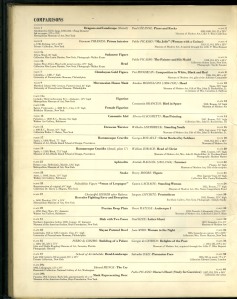The Teaching Portfolios were a happy coincidence I found in the Gimbel library. As I was hoarding any book with MoMa in the title, I came upon these two. I was initially drawn to the books’ old smell but upon further examination I discovered they had further value, they were old teaching aids. These books were constructed in 1950 as a way for teachers to educate in art.
 [2]
[2]
They are completely devoid of writing or explanation but stand alone as the objects that artists and students should know. They are curated as the MoMA believed objects should be referenced. Like with Alfred Barr’s 1936 exhibit on Cubism and Abstract art, interestingly enough these are done in series. The first of which focuses on the human form and all artworks related to it, while the second focuses on useful objects. It is curious to see how the teachers portfolio subject matter were decided and how the culture of the time influences what gets curated and shown attention. How did they develop the five themes of the exhibits and the themes for each book? The designers of these two educational outlets have the power to attract attention into whichever themes they desire.
If you click and enlarge this image, you can see that in the purpose section it states, “The aim is to show that a kinship often exists between works of art from different epochs although each one is of course conditioned by the phase of civilization that produced it.” No explanation is offered beside any of the pictures, which is the same in the majority of exhibited works at the MoMA.
The only other page with any writing is the final page in the book that lists the work titles and creates another sort of diagram for the reader to understand the connections between the artists.
These pages act as though the only information you need are the objects and from their collection together, the viewer can understand the importance. It is almost as if they are using visual analogies so that the students can infer their meaning.
[1], [3], [4]
MoMA, Teaching Portfolio Number 3: Modern Art Old and New (NY: MoMA, 1950), 1.
[2],[5],[6]
MoMA, Teaching Portfolio Number 4: Useful Objects Today (NY: MoMA, 1950), 1.




 [6]
[6]